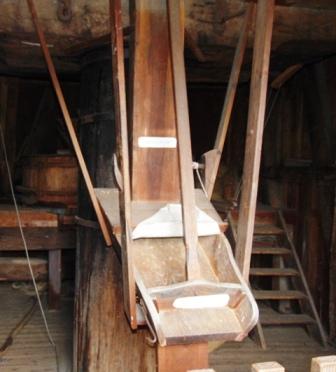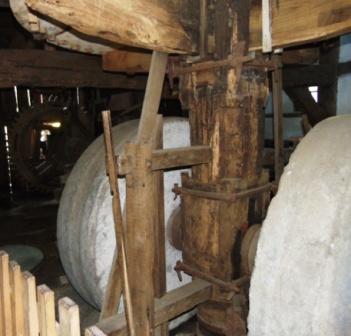Mills are devices to proces raw material with a circular motion, usually creating fine crushing: pepper mill, meat grinder, coffee grinder, grinding mill. In principle, this may also be in a mortar. In a mill this may be a quasi- continuous process.
Mills can be classified according to the driving force:
tidal mill, hand mill, horse mill, ship mill (floats on water and is therefore independent of the water hight), treadmill (running human or animal), water mill, wind mill.
 At the Pei Ho River (Tianjin, China) chain pumps were powered by a set up of sails at 8 vertical spokes on a horizontally wheel.Thus, the wind usually provided sufficient water to fill salt pans regularly.
At the Pei Ho River (Tianjin, China) chain pumps were powered by a set up of sails at 8 vertical spokes on a horizontally wheel.Thus, the wind usually provided sufficient water to fill salt pans regularly.
The use of windmills as drive provides plenty of extra power.
Man uses an energy output of 90 watts for heating and the heart muscle (5 watts). Mechanically we perform 150 watts of power (300 watts for an athlete), with a yield of 25%.
Manual cutting wood requires 600 watts of power, of which 450 watts dissipates by sweating.
One horsepower (hp) is 736 watts. A horse delivers the power of nearly 5 workers (of which the power, but not the speed can be accumulated).
A mill had around 1700 a maximum power of 40 kW at an efficiency of 40%. That represents about 20 horses.
The inventor of the steam engine, the Scotsman James Watt in 1770 defined the horsepower: 1 HP is the ability of a horse to lift 150 kilograms of 30 meters in a minute. The strength of a horse varies individually, just as in humans. A person can develop a very short time 1 / 4th to 1.2 HP. A much longer keeping ratio is 0,1PK (athletes: 0.3).
In competitions it sometimes works to stop a draft horse with 14 men. But just as easy a horse drags 18 men.
The new, in 1767 by James Watt improved steam engine had an output of 10 to 200 hp. In 1900 there were large ships with steam engines with a capacity of 70.000 hp.
M illstones work in pairs. A couple consists of a bed stone (flat or slightly convex) and a runner (top, slightly concave). Through the eye grain can come between the stones.
illstones work in pairs. A couple consists of a bed stone (flat or slightly convex) and a runner (top, slightly concave). Through the eye grain can come between the stones.
From the inside out a mill stone has three zones. Central for dividing, in the middle a part to break grain and in the end to grind.
Both stones have fan-shaped grooves or rays with head cut and (sometimes) other nicks and patterns.
The back of the notch has a steep edge, with which the grains are broken by the cutting action and then further are finely ground out.
Millstones wear. The grooves may be further dressed with a hammer. If the runner is too thin, he spends his life further as a bed rock.
To grind line (seed) cake or chop coarser material like oak (tan) bark stones had wider openings.
